BRISTOL
CHANNEL REPORT
Words and
images by Martin Longhurst
Waverley had a
reaonably good passage south. Conditions got a bit lumpy at one
stage though, and she anchored for a while off Peel, Isle of Man.
The weather was glorious for her arrival on the Bristol Channel,
but broke the moment she started boarding passengers.
For the first two days
it was impossible to berth at Clevedon owing to the wind and
swell. On Friday 21 May, some Penarth passengers had already been
landed at Minehead for a Somerset Villages coach tour before this
became evident. They were due to re-embark at Clevedon, but had
to be coached backed to Penarth. On arrival at Penarth, the 11
passengers from Minehead were take back in the same coaches. As
there was no diversionary port available, the remaining
passengers had to remain on board while the ship anchored for
over an hour waiting for sufficient water at Penarth. On the
following day a series of non-landing cruises from Penarth were
given as no other calls, other than at Clevedon, were scheduled
or indeed possible. Loadings were light for the first week's
public sailings, but there were good numbers for the evening
charters.
Waverley was due to
take bunkers on Friday evening 28 May ready for her 0930
departure from Penarth on the Saturday morning. Unfortunately the
fuel suppliers were unable to deliver the fuel until Saturday
morning. This left Captain Gellatly no choice but to cancel the
early Penarth sailing and arrange for the 85 passengers to be
coached direct to Bishops Lydeard for their ride on the West
Somerset Railway.
 |
We
joined the ship at Clevedon being surprised to see the
paddler approaching from the east while she should have
been tied up at the Pier for an hour and three quarters.
As you can see this did provide an unexpected
opportuntity for digital photography. As the wind and
tide were from the east, Captain Gellatly had to swing
the ship to stem the tide from the west. A slow approach
brought the paddler gently alongside without difficulty. Note
the Scottish saltaire flying in the bow. |
| The name pennant is being flown
from the Pier. |
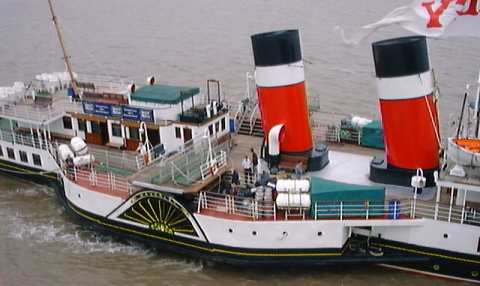 |
Soon after leaving
Clevedon the weather closed in with spectacular lightning,
thunder and torrential rain. At this point a request from was
received from Swansea Coastguard for Waverley to assist in a
search for a missing vessel. A distress signal had been activated
apparently between Flat Holm and Steep Holm. This was later found
to be a false alarm, perhaps caused by the electrical storm.
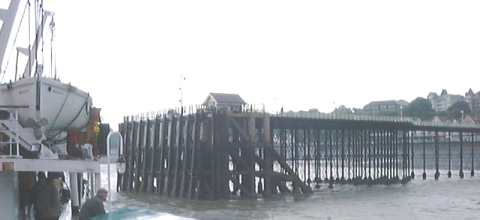 |
Waverley had to wait for the tide
to rise sufficiently at Penarth before she could berth at
the Pier, which dries out with each low tide despite its
considerable height. The tide was about half an hour
later than predicted. |
Not surprizingly, following the violent storm, there
were only a few brave souls waiting on the Pier. However, the
weather gradually improved as the day progressed. The next port
was Minehead and this calls for a direct course across the
Channel. Minehead Harbour is only available for Waverley for
about two hours each tide which makes calls here fairly unusual
and round trips even rarer. Waverley berths inside the
substantial stone harbour wall with small craft berthed a few
feet ahead of her bow. A short cruise to Porlock Bay and back was
given for Minehead passengers and we were also joined by many
Penarth passengers who had arrived by steam train some four hours
earlier. Following the second call at Minehead,where we picked up
the remaining Penarth passengers and the Clevedon passengers who
had gone ashore, Waverley headed back up Channel without further
incident.
For operational reasons
it was not possible for Waverley to call at Bristol this year and
coach connections were laid on to take passengers to Avonmouth or
Clevedon on 31 May and 1 June. The sailings took place as
scheduled apart from this. The cruise on Bank Holiday Monday
westward from Ilfracombe reached Woolacombe Bay, well passed Bull
Point, with excellent views beyond Hartland Point of mystical
Duchy of Cornwall.
Saturday 5 June was rather stormy and
there was some doubt about whether the sailing from Swansea could
go ahead. 230 passengers took the plunge, however, and enjoyed a
rough crossing to Ilfracombe. Before leaving Swansea Bay,
Waverley passed close to Mumbles Pier, currently under
restoration. The planned special call was not possible as the
pier is not yet ready to receive shipping. On arrival at
Ilfracombe, after consultation with Lundy Island and the M.V.
Oldenburg (the Lundy ferry), it was decided that conditions would
not permit the onward passage to Lundy.
The annual Wildlife Trust cruise to the
Pembrokeshire Islands took place on Sunday 6 June. This is a
round trip from Milford Haven and is always very popular, this
year with 618 on board. Conditions had improved considerably with
a long Atlantic swell running. It was possible to reach the
islands of Grasholm, via The Smalls to Ramsey Island, Round
Ramsey Island with close views of St David's Head, through the
notorious Jack Sound, Round Skokholm then into St Bride's Bay
back through Jack Sound and then around the west side of Skomer
back to Milford Haven. Among the many species of birds noted were
gannets, puffins, kittewakes and Manx shearwaters.
| Saturday 12 June
saw a trip from Penarth and Clevedon for time ashore at
Ilfacombe for the Victorian Festival there. Captain
Colledge had taken over from Captain Gellatly who had
taken some leave before assuming command of M.V. Balmoral
during her stint on the River Thames. Here the paddler is
seen approaching Clevedon Pier with the Welsh Dragon at
her bow. Once again an inclusive steam railway trip was
being offered from Penarth which accounts for the packed
decks. |
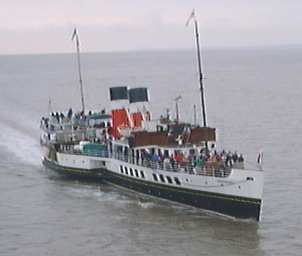 |
 |
After a short
shower just after leaving Clevedon the weather steadily
improved during the day although temperatures remained
low. An hour and three-quarters was given at Ilfracombe
before Waverley turned her bows eastward. A quick call
was made at Minehead to pick up the steam railway
passengers before heading for the Welsh shore at Penarth.
This view shows
the windlass used to haul in mooring lines and to raise
the anchor. It is driven by a two cylinder steam engine
(silver) which is controlled by the two lower red handles
- the circular one changes the direction while the other
controls the steam supply. The upper red handle is the
brake on the anchor chain.
|
| The evening sun lit Clevedon Pier
as we arrived at 2100 at the end of the cruise. The
Pavilions were replaced last year as part of a Heritage
Lottery Fund project to restore the Pier Head. |
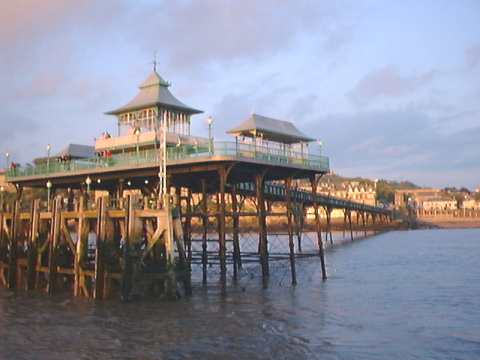 |
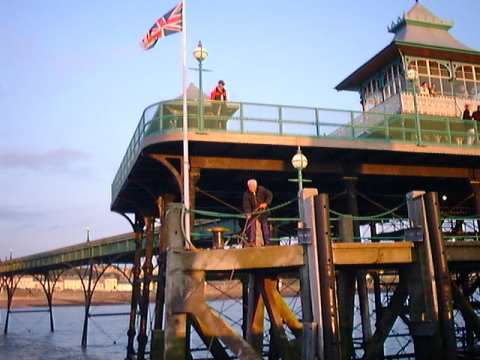 |
Veteran seaman Ray Buck hauls in
the for'ard heaving line (from the bow) as Waverley comes
alongside. The tide rises and falls 47 feet here so the
current is strong. |
| The paddles start going astern to
slow the ship, pushing their wash out against the tide.
The heaving line for the for'ard spring mooring line,
which is run out from the sponson below, can be seen over
the hand rail ready to be thrown ashore. Below
her passengers disembarked, Waverley slowly paddles out
to anchor for the night just off the Pier. It is now 2130
and she is due to start boarding at 0730 on Sunday.
|
 |
Sunday 13 June was the Annual Waverley
Church Service at St Helena's Church on Lundy. To give maximum
time on the Island, early departures and late returns are
necessary. Clevedon was left at 0800 and Penarth at 0900. Among
the passengers were the acting couple Prunella Scales and Timothy
West, who read a lesson at the Service.
On the return passage about 4 miles off
Foreland Point, Waverley
sustained damage to No. 1 float on her port wheel. This element
of the wheel is critical as it drives the feathering gear on the
remaining floats. Three radius rods were bent and the damage was
such that it was impossible to effect repairs at sea and a tug
had to be summoned. The
tide carried Waverley westwards until she anchored off Lynmouth.
As the extent of the damage became clear, passengers were offered
complimentary tea, coffee, biscuits and chips. The tug Holm Garth
arrived at about 0130 on Monday but a speedy tow was not possible
as to do so might have caused further damage to the crippled
wheel. This was only possible because the tide had turned and
carried both paddler and tug eastwards. During the incident
Waverley was escorted by Barry Lifeboat.
Approaching Barry Docks another tug,
Port Garth, took a line from Waverley's stern and the two tugs
gently manouevred the paddler slowly into the lock and finally
spun the ship round inside the Docks to berth her port side to in
order to facilitate repairs. The final arrival was about 0800
and passengers were then coached to Penarth and Clevedon.
Gordon Reid, the
Rebuild Project Manager, transported spare parts from the store
at Anderston Quay, Glasgow, to the ship during the day on Monday.
The wheel was rebuilt overnight so that Waverley could resume
service on Tuesday. Waverley
took up her timetable at Clevedon at 1130 on Tuesday with
passengers from Sharpness being coached down.
The call at Weston on 17 June did not
take place as planned due to building work at Knightstone Harbour
which would have prevented passengers landing. Instead passengers
were transferred between ship and shore by launch.
Return to
Waverley Writings








